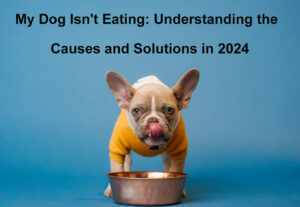It can be concerning when your dog suddenly stops eating. As a pet owner, you might feel anxious and wonder what could be wrong. A loss of appetite in dogs can be due to various reasons, ranging from minor issues to serious health concerns. In this article, we’ll explore common causes for a dog not eating, when to seek veterinary help, and tips to encourage your furry friend to eat again.

Why Is My Dog Not Eating?
1. Health Issues
One of the most common reasons a dog may refuse food is underlying health problems. Some potential health issues include:
- Dental Problems: Dogs with toothaches or gum disease may find it painful to eat. Check for signs like bad breath, swollen gums, or difficulty chewing.
- Gastrointestinal Distress: Conditions such as nausea, vomiting, or diarrhea can make your dog reluctant to eat. Keep an eye on their overall behavior and bathroom habits.
- Infections or Illness: Various infections, such as kennel cough or more severe conditions, can lead to a decreased appetite. If your dog shows other symptoms like lethargy or coughing, consult your veterinarian.
- Chronic Diseases: Conditions like kidney disease, liver problems, or diabetes can impact a dog’s appetite. Regular veterinary check ups are crucial for managing these health concerns.
Read Also:Ibomma Telugu Movies
2. Dietary Changes
If you’ve recently switched your dog’s food or introduced new treats, they may not like the new taste or texture. Dogs can be picky eaters, and abrupt changes in their diet can lead to reluctance to eat.
3. Stress or Anxiety
Changes in a dog’s environment, such as moving to a new home, the arrival of a new pet or family member, or even loud noises (like thunderstorms or fireworks) can cause stress and lead to a loss of appetite.
4. Age and Life Stage

Puppies, adult dogs, and senior dogs have different nutritional needs. If your dog is a senior, they may naturally eat less due to decreased activity levels. Puppies may also experience changes in appetite as they grow and transition from nursing to solid food.
5. Behavioral Issues
Sometimes, a dog may refuse food as a way of seeking attention or as a behavioral response to training methods. If your dog has learned that refusing food gets them extra attention from you, they may continue this behavior.
When to Seek Veterinary Help

While occasional appetite loss can be normal, there are times when it’s essential to consult your veterinarian. Consider seeking professional advice if:
- Loss of Appetite Persists: If your dog hasn’t eaten for more than 24 hours, it’s time to call the vet.
- Accompanied Symptoms: If your dog shows other concerning signs such as vomiting, diarrhea, lethargy, or behavioral changes, don’t hesitate to get professional help.
- Weight Loss: Rapid weight loss can indicate serious health issues. Regularly monitor your dog’s weight, especially if they’re not eating.
Read Also: The Best Basenji Yodels – Best Guide 2022
Tips to Encourage Your Dog to Eat

If your dog isn’t eating but isn’t showing signs of a serious health issue, there are several strategies you can try to encourage them to eat again.
1. Warm Up Their Food
Heating your dog’s food can enhance its aroma and make it more appealing. You can slightly warm up wet food in the microwave or add warm water to dry kibble to create a more enticing meal.
2. Offer Different Foods
Experiment with different types of food. Some dogs prefer wet food over dry kibble, while others may enjoy a mix. You might also try adding a small amount of plain cooked chicken, rice, or low sodium broth to their food to make it more appealing.
3. Create a Routine
Establishing a regular feeding schedule can help your dog understand when it’s time to eat. Limit the amount of time food is left out, and offer it at the same times each day. After 15 30 minutes, remove the food if it hasn’t been eaten.
4. Minimize Stress

If you suspect stress or anxiety is causing your dog to refuse food, work on creating a calm environment. Provide a quiet, comfortable space for them to eat, and consider using calming aids, such as pheromone diffusers or anxiety wraps.
5. Limit Treats
Excessive treats can spoil a dog’s appetite. Ensure you’re not giving too many snacks throughout the day, as this can lead to disinterest in their regular meals.
6. Encourage Exercise
Regular exercise can stimulate your dog’s appetite. Take them for walks or engage in playtime to encourage a healthy routine and promote hunger.
7. Consult Your Veterinarian
If you’ve tried various methods to encourage eating and your dog still refuses food, it’s best to consult your veterinarian. They can provide guidance, perform necessary tests, and help identify any underlying health issues.
Conclusion

Seeing your dog not eating can be alarming, but understanding the possible causes can help you take appropriate action. While occasional loss of appetite may not be serious, persistent refusal to eat can indicate underlying health issues that require veterinary attention. By implementing the tips provided and maintaining open communication with your vet, you can help your furry friend regain their appetite and ensure they remain healthy and happy.
Read Also: When Is An Aussiedoodle Full Grown – Best Guide in 2022